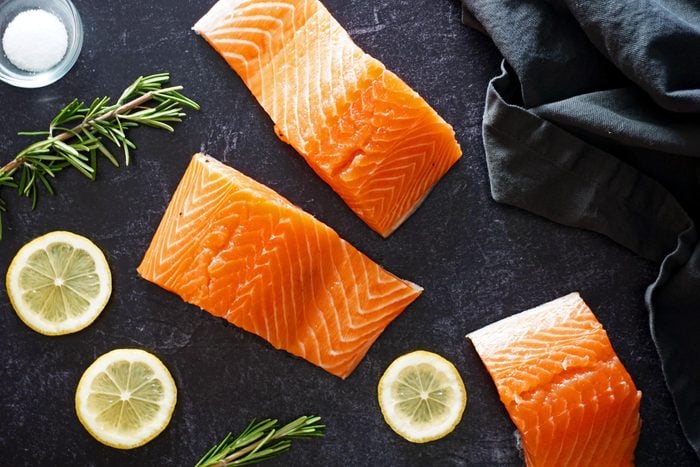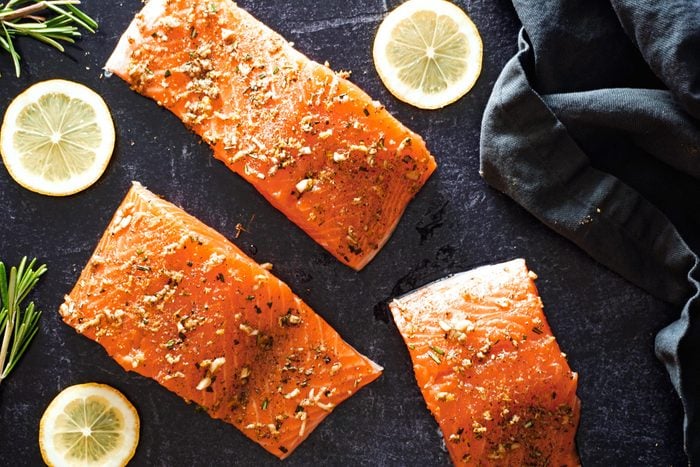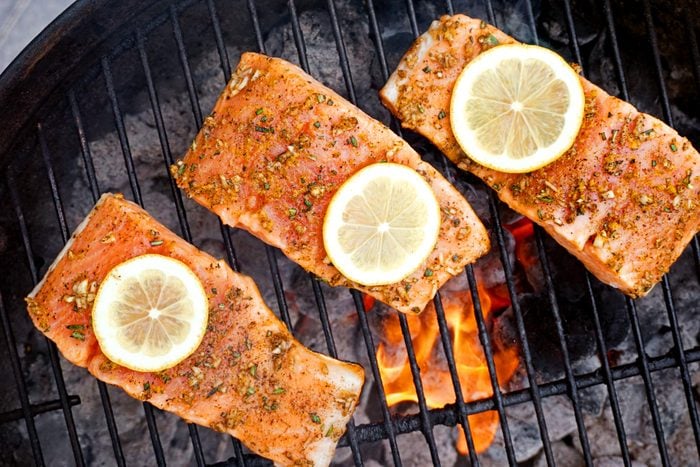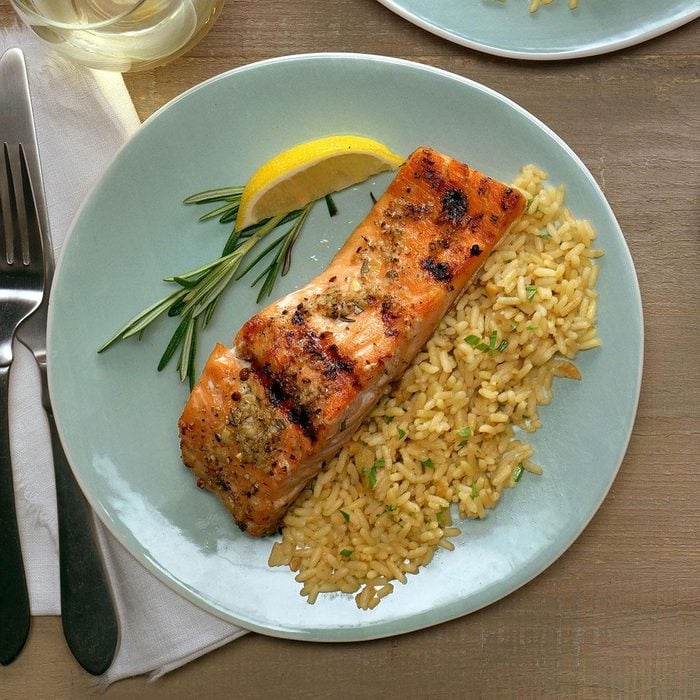It can be nerve-wracking to make grilled salmon. Compared to hearty burgers and steaks, salmon fillets look so tender and delicate. But the grill is a perfect cooking method for salmon. The smokiness is a subtle way to amp up salmon’s mild flavor, and the high heat creates a delicious charred finish.
The only problem with grilling fish is that it flakes. If it sticks to the grill, you’ll watch your dinner crumble into the fiery inferno below. Luckily, we have good news: Fish doesn’t have to stick to the grill. In fact, it’s easily avoidable. Learn how to grill salmon—without it sticking—by adopting a few simple techniques.
Best Salmon for Grilling
You have a few choices regarding how to buy salmon. For grilled salmon, choose fillets or steaks. The fillets tend to be a bit thinner, so they’ll cook more quickly than the steaks, but both options work well on the grill. Whether you plan to eat the skin or not, it’s always best to opt for skin-on salmon, too. The skin gives you a buffer between the delicate flesh and the hot grill, protecting the salmon from sticking.
We always opt for wild-caught salmon when we have the option. It’s naturally leaner, so you’ll need to watch it carefully to keep it from overcooking. But we love its bolder color and more complex, salmon-forward flavor. Farm-raised salmon might be a better fit for some picky eaters, though, because it has a mellower flavor. It also contains more fat, so it’s more forgiving to cook.
When it comes to prepping and cooking the salmon, fresh (never frozen) is ideal; however, frozen salmon will work in a pinch. Just plan to double the time it takes to cook.
Grilled Salmon Ingredients

- Garlic cloves
- Grated lemon zest
- Salt
- Minced fresh rosemary
- Pepper
- Salmon fillets
Directions
Step 1: Prepare the grill
The best way to keep the salmon from sticking is to start with a clean, preheated grill. You’re looking for medium-high heat, or 400 to 450°F.
For a charcoal grill, prepare the coals until they’re covered with gray ash and spread them out in an even layer. When you can hold your hand five inches above the coals for 3 to 4 seconds, the grill is ready to go. For a gas grill, turn the burners to medium-high and close the cover for about 15 minutes. When the grill is fully preheated, clean the grill grates before moving on to the next step.
Step 2: Season the salmon

In a small bowl, mix together the garlic, lemon zest, salt, rosemary and pepper. Rub the herb mixture over the salmon fillets. Let stand 15 minutes. For a simpler take, rub each side of the salmon with a little bit of cooking oil and season with a sprinkle of kosher salt and pepper.
Step 3: Grill the salmon

Prepare the grill by moistening a paper towel with cooking oil. Using long-handled tongs, rub the oiled towel onto the grill rack, moving from the back of the grill toward the front. Place the salmon directly on the grill grates, skin side down. Place the cover on the grill. After about 4 minutes, the salmon should release easily from the grill grates. Flip the fish over and cook for an additional 3 to 6 minutes, until it reaches the desired temperature (125° for medium fish, or 145° for a fish that flakes more easily with a fork).
Editor’s Tip: For the easiest flipping, invest in a fish spatula. The edge and slots don’t tear at the delicate flesh.
Step 4: Let it rest
Salmon needs to rest after cooking. Given the fillet’s small size, you should only need about 5 minutes. Then, remove the skin (or eat it if it’s crispy enough for your liking) and serve.
Grilled Salmon Variations
When it comes to seasoning grilled salmon, you have a lot of yummy options.
- Salt and pepper: For the simplest preparation, you can’t go wrong with a sprinkling of salt and pepper. To take things up a notch, consider using a packaged seasoning blend, or make your own spice blend from scratch.
- Citrus zest: Citrus zest adds a little sweetness and zing to the salmon. Lemon, lime, orange and grapefruit zests are all delicious options. We recommend using a microplane to zest citrus.
- Fresh herbs: Salmon pairs well with a number of different herbs. Try rosemary, basil, oregano, thyme, dill, parsley or tarragon. Dried herbs can be substituted for fresh herbs in a pinch. Because dried herbs pack more of a flavor punch, reduce the amount by one-third to one-fourth. For example, in a recipe that calls for 1 tablespoon of fresh herbs, you would use 1 teaspoon of dried herbs.
- Marinades and sauces: If you have time before grilling the salmon, consider making a sauce or salmon marinade. This Ginger Salmon with Cucumber Lime Sauce features ingredients such as ginger, spices, lime zest and cucumber. Ginger is also a featured ingredient in our recipe for Ginger Honey Salmon.
Grilled Salmon Tips
How do you flip grilled salmon?
When you’re cooking salmon fillets or steaks over direct heat, flip them halfway through. If you started with a clean, preheated and oiled grill, your salmon won’t stick! After 4 minutes on a hot grill, the salmon will naturally release. Simply get under it with a thin, flat spatula and gently flip it over to finish cooking.
If the idea of flipping the fish makes you nervous, skip it. Instead, cook the fish skin-side down and close the lid for the entire cooking time. The ambient heat of the grill will heat the fish all the way through, although the top won’t have a beautiful grilled appearance.
Grilling the salmon on a cedar plank is another option for no-flip grilled fish. This technique cooks the fish over indirect heat, and it never comes in contact with the grill grates. Learn how to pull it off with our guide to cedar plank grilling. If you don’t have cedar planks on hand, grill salmon in a foil packet.
How do you prevent grilled salmon from sticking?
Keeping the fish from sticking to the grill is a three-pronged approach: you need a clean, preheated and oiled grill.
Dirty grill grates increase the chances of food sticking, so start by cleaning your grill. The grill is easiest to clean when preheated, so do that at the same time. Then, before you start cooking, oil both the fish and the grill grates. Rub some cooking oil on a paper towel and, using tongs, lightly coat the grill rack with the oil. You may get a few flare-ups during this process, so always move the tongs from the back of the grill toward the front to protect the hairs on your arms.
What’s the best temperature for grilled salmon?
The best way to know when salmon is finished cooking is to use a thermometer. The USDA recommends cooking salmon to an internal temperature of 145°F. While that temperature results in a moist, flaky fish, we prefer our fish a little closer to medium—125°.
If you don’t have a thermometer, pay attention to the color of the fish on the side of the fillet. You’re looking for that translucent pink to turn an opaque white as it creeps up towards the top of the fish. If you gently poke the fish with a fork, it should turn into flaky pieces.
How long do you grill salmon?
In general, direct heat grilled salmon should take about 8 minutes per inch of thickness, or about 4 minutes per side. Most fillets are an inch or thinner, but salmon steaks can be a little thicker, so you may need additional time.
For indirect heat cedar plank or foil packet grilled salmon, plan on anywhere from 10 to 15 minutes, depending on the size of the salmon.
Can you grill salmon indoors?
If you don’t have a grill, you can still cook a grill-like salmon indoors. Cook the salmon in a preheated cast-iron skillet to get a similar sear to what you’ll find on the grill. Or take advantage of your broiler. It’s essentially a reverse grill, where the heating element is on top of the food instead of the bottom. After preheating the broiler to high, position the salmon four inches below the element. Then, cook it according to the recipe above, flipping it halfway through.
What do you serve with grilled salmon?
Salmon is delicious on its own, but that doesn’t mean you can’t complement it with a tasty sauce or side dish. Try making a tangy dill sauce to serve over the salmon, or top it with an easy flavored butter.
As far as side dishes go, you can’t go wrong with grilled vegetables. Try whipping up some foil-pack vegetables, or make your favorite potato salad recipe. For something a little different, serve salmon with Mediterranean lentils or quinoa with peas and onions.

